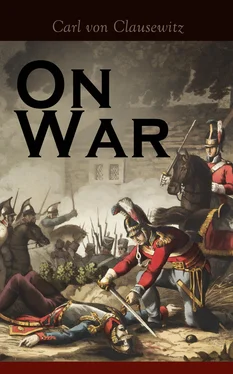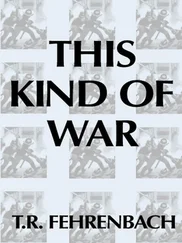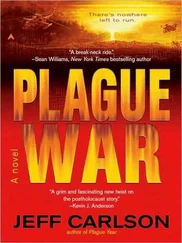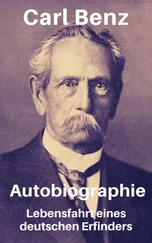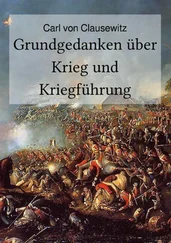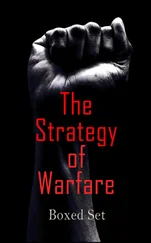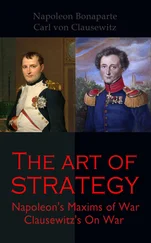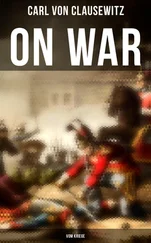Carl von Clausewitz
Military Theory Classic (Vom Kriege)
Translator: J. J. Graham
e-artnow, 2021
Contact: info@e-artnow.org
EAN: 4064066388133
Introduction
Preface to the First Edition
Notice
The Introduction of the Author
Brief Memoir of General Clausewitz (by Translator)
Book I. On the Nature of War
Chapter I. What is War?
Chapter II. Ends and Means in War
Chapter III. The Genius for War
Chapter IV. Of Danger in War
Chapter V. Of Bodily Exertion in War
Chapter VI. Information in War
Chapter VII. Friction in War
Chapter VIII. Concluding Remarks, Book I
Book II. On the Theory of War
Chapter I. Branches of the Art of War
Chapter II. On the Theory of War
Chapter III. Art or Science of War
Chapter IV. Methodicism
Chapter V. Criticism
Chapter VI. On Examples
Book III. Of Strategy in General
Chapter I. Strategy
Chapter II. Elements of Strategy
Chapter III. Moral Forces
Chapter IV. The Chief Moral Powers
Chapter V. Military Virtue of an Army
Chapter VI. Boldness
Chapter VII. Perseverance
Chapter VIII. Superiority of Numbers
Chapter IX. The Surprise
Chapter X. Stratagem
Chapter XI. Assembly of Forces in Space
Chapter XII. Assembly of Forces in Time
Chapter XIII. Strategic Reserve
Chapter XIV. Economy of Forces
Chapter XV. Geometrical Element
Chapter XVI. On the Suspension of the Act in War
Chapter XVII. On the Character of Modern War
Chapter XVIII. Tension and Rest
Book IV. The Combat
Chapter I. Introductory
Chapter II. Character of a Modern Battle
Chapter III. The Combat in General
Chapter IV. The Combat in General (continuation)
Chapter V. On the Signification of the Combat
Chapter VI. Duration of Combat
Chapter VII. Decision of the Combat
Chapter VIII. Mutual Understanding as to a Battle
Chapter IX. The Battle(*)
Chapter X. Effects of Victory
Chapter XI. The Use of the Battle
Chapter XII. Strategic Means of Utilising Victory
Chapter XIII. Retreat After a Lost Battle
Chapter XIV. Night Fighting
Book V. Military Forces
Chapter I. General Scheme
Chapter II. Theatre of War, Army, Campaign
Chapter III. Relation of Power
Chapter IV. Relation of the Three Arms
Chapter V. Order of Battle of an Army
Chapter VI. General Disposition of an Army
Chapter VII. Advanced Guard and Out-Posts
Chapter VIII. Mode of Action of Advanced Corps
Chapter IX. Camps
Chapter X. Marches
Chapter XI. Marches (Continued)
Chapter XII. Marches (continued)
Chapter XIII. Cantonments
Chapter XIV. Subsistence
Chapter XV. Base of Operations
Chapter XVI. Lines of Communication
Chapter XVII. On Country and Ground
Chapter XVIII. Command of Ground
Book VI. Defence
Chapter I. Offence and Defence
Chapter II. The Relations of the Offensive and Defensive to Each Other in Tactics
Chapter III. The Relations of the Offensive and Defensive to Each Other in Strategy
Chapter IV. Convergence of Attack and Divergence of Defence
Chapter V. Character of the Strategic Defensive
Chapter VI. Extent of the Means of Defence
Chapter VII. Mutual Action and Reaction of Attack and Defence
Chapter VIII. Methods of Resistance
Chapter IX. Defensive Battle
Chapter X. Fortresses
Chapter XI. Fortresses (Continued)
Chapter XII. Defensive Position
Chapter XIII. Strong Positions and Entrenched Camps
Chapter XIV. Flank Positions
Chapter XV. Defence of Mountains
Chapter XVI. Defence of Mountains (Continued)
Chapter XVII. Defence of Mountains (continued)
Chapter XVIII. Defence of Streams and Rivers
Chapter XIX. Defence of Streams and Rivers (continued)
Chapter XX. A. Defence of Swamps
B. Inundations
Chapter XXI. Defence of Forests
Chapter XX. The Cordon
Chapter XXIII. Key to the Country
Chapter XXIV. Operating Against a Flank
Chapter XXV. Retreat into the Interior of the Country
Chapter XXVI. Arming the Nation
Chapter XXVII. Defence of a Theatre of War
Chapter XXVIII. Defence of a Theatre of War—(continued)
Chapter XXIX. Defence of a Theatre of War (continued) Successive Resistance.
Chapter XXX. Defence of a Theatre of War (continued) When no Decision is Sought for.
Sketches for Book VII. The Attack
Chapter I. The Attack in Relation to the Defence
Chapter II. Nature of the Strategical Attack
Chapter III. Of the Objects of Strategical Attack
Chapter IV. Decreasing Force of the Attack
Chapter V. Culminating Point of the Attack
Chapter VI. Destruction of the Enemy’s Armies
Chapter VII. The Offensive Battle
Chapter VIII. Passage of Rivers
Chapter IX. Attack on Defensive Positions
Chapter X. Attack on an Entrenched Camp
Chapter XI. Attack on a Mountain
Chapter XII. Attack on Cordon Lines
Chapter XIII. Manœuvring
Chapter XIV. Attack on Morasses, Inundations, Woods
Chapter XV. Attack on a Theatre of War with the View to a Decision
Chapter XVI. Attack on a Theatre of War without the View to a Great Decision
Chapter XVII. Attack on Fortresses
Chapter XVIII. Attack on Convoys
Chapter XIX. Attack on the Enemy’s Army in its Cantonments
Chapter XX. Diversion
Chapter XXI. Invasion
Chapter XXII. On the Culminating Point of Victory
Sketches for Book VIII. Plan of War
Chapter I. Introduction
Chapter II. Absolute and Real War
Chapter III. A. Interdependence of the Parts in War
B. On the Magnitude of the Object of the War, and the Efforts to be Made.
Chapter IV. Ends in War More Precisely Defined Overthrow of the Enemy
Chapter V. Ends in War More Precisely Defined (continued) Limited Object
Chapter VI. A. Influence of the Political Object on the Military Object
B. War as an Instrument of Policy
Chapter VII. Limited Object—Offensive War
Chapter VIII. Limited Object—Defence
Chapter IX. Plan of War when the Destruction of the Enemy is the Object
Table of Contents
The Germans interpret their new national colours—black, red, and white—by the saying, “Durch Nacht und Blut zur licht.” (“Through night and blood to light”), and no work yet written conveys to the thinker a clearer conception of all that the red streak in their flag stands for than this deep and philosophical analysis of “War” by Clausewitz.
It reveals “War,” stripped of all accessories, as the exercise of force for the attainment of a political object, unrestrained by any law save that of expediency, and thus gives the key to the interpretation of German political aims, past, present, and future, which is unconditionally necessary for every student of the modern conditions of Europe. Step by step, every event since Waterloo follows with logical consistency from the teachings of Napoleon, formulated for the first time, some twenty years afterwards, by this remarkable thinker.
What Darwin accomplished for Biology generally Clausewitz did for the Life-History of Nations nearly half a century before him, for both have proved the existence of the same law in each case, viz., “The survival of the fittest”—the “fittest,” as Huxley long since pointed out, not being necessarily synonymous with the ethically “best.” Neither of these thinkers was concerned with the ethics of the struggle which each studied so exhaustively, but to both men the phase or condition presented itself neither as moral nor immoral, any more than are famine, disease, or other natural phenomena, but as emanating from a force inherent in all living organisms which can only be mastered by understanding its nature. It is in that spirit that, one after the other, all the Nations of the Continent, taught by such drastic lessons as Königgrätz and Sedan, have accepted the lesson, with the result that to-day Europe is an armed camp, and peace is maintained by the equilibrium of forces, and will continue just as long as this equilibrium exists, and no longer.
Читать дальше
